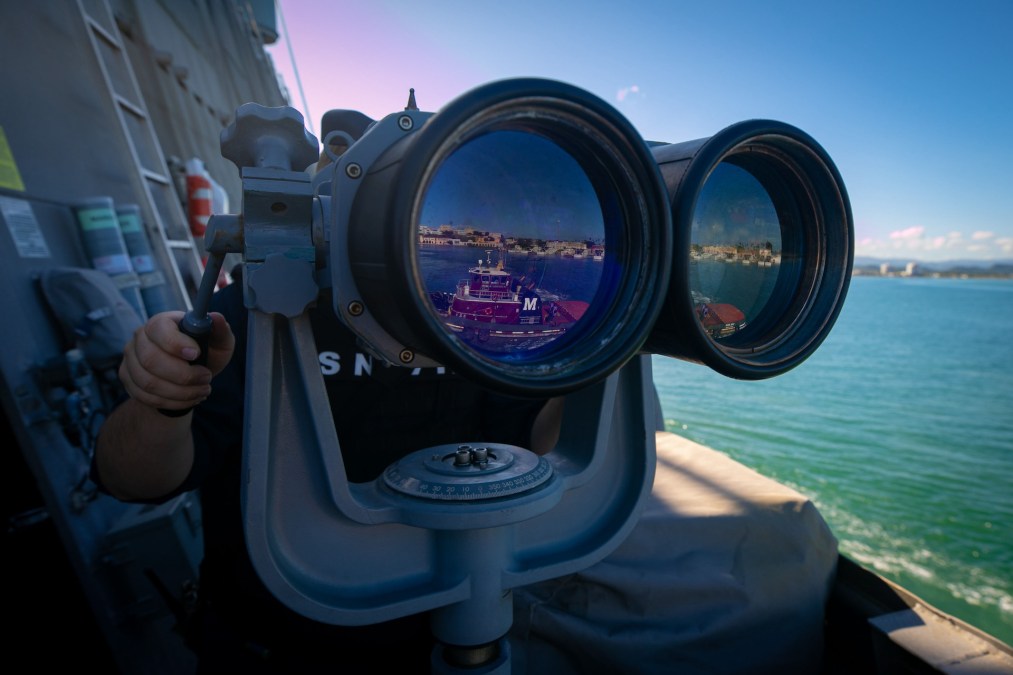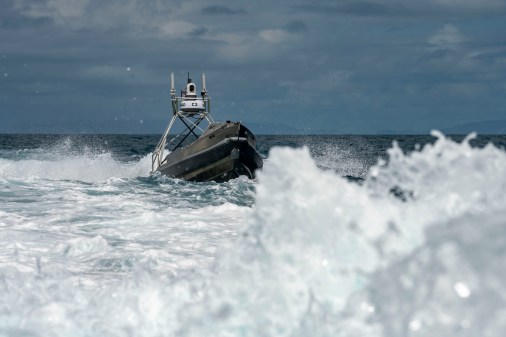A first look at Naval Oceanography’s new ‘North Star’ data strategy

Officials in the Naval Oceanography enterprise (NOe) spent the last nearly two years crafting and refining an original data strategy that sets their unique organization’s overarching guiding principles, essential capabilities, goals and objectives to ultimately enable secure and seamless access to U.S. meteorological, oceanographic, position, time and astrometry data.
NOe components include the Oceanographer of the Navy, the operational commander Naval Meteorology Oceanography and Meteorology Command, and subordinate Echelon IV and V commands. Naval Information Forces, research labs, warfare centers and fleet commanders are also among its cadre of stakeholders.
So, its data arsenal is vast and growing.
“From literally mapping the bottom of the ocean floor to creating databases of stars to use as fixed reference frames for celestial navigation — that is a lot of data to encompass by one enterprise,” Jennifer Taylor, NOe’s principal assistant for data, recently said.
Trained in atomic physics, Taylor spent nine years building atomic clocks for the Navy-run Defense Department master clock at the Naval Observatory, before she was tapped in 2021 to produce the Naval oceanographer’s first-ever enterprise data strategy. She spent more than 18 months working closely with Naval Oceanography’s science-and-technology branch head Cmdr. Erin Ceschini — a meteorology and oceanography officer with two decades of Navy service — and engaging others across the broad unit, as part of the effort.
In a recent joint interview at the Pentagon, Taylor and Ceschini gave DefenseScoop an exclusive first look at that new data strategy, and shared their vision for how it will be applied and inevitably evolve.
“This is what’s going to help us do what we need to do in the future — whether it’s in peacetime, in competition, or in conflict,” Ceschini said.
Words matter
On Navy deployments in waters around the world, Ceschini worked “on everything from the bottom of the ocean through the stars, which is kind of our community’s tagline,” she said.
That U.S. military oceanographic community has been collecting and applying data for decades.
“We can’t do what we do in terms of informing the decision-makers about the environmental characterization without data — whether it’s current observational data, whether it’s bathymetric survey data, whether it’s celestial data that we use for navigation — we use data for everything,” Ceschini explained.
Considered the Navy’s “authoritative source for the characterization and application of knowledge of the physical battlespace,” NOe depends on data to help the U.S. armed forces deter aggression, maintain freedom of the seas and ultimately win wars.
The enterprise’s datasets span long periods of time at small and large intervals. It’s heaps of data — but it’s not all uniformly available across different places around the world.
“The amount of data that we have at any given moment in time over land is significantly more than we have over the same square or cubic mile, or volume, of the ocean — based on our ability to sense,” Ceschini said, adding that data is also more accessible on coastlines and other places with more sensors deployed than in areas out in the middle of oceans.
The Navy’s oceanographer opted to create a new billet to hire a principal assistant for data to make sense of and strategize with the hub’s increasingly complex assets. And in 2021, Taylor took on the first-of-its-kind role.
That position “was very nebulous at the time. The only guidance was: ‘Think about data in the enterprise and what do we need to do,’” Taylor said.
“So, with the many data strategies that were coming out — the Federal Data Strategy, [Defense Department’s] Data Strategy, and also the Navy’s implementation plan of the DOD Data Strategy — it seemed that creating a strategy that was specific to the complex Naval Oceanography enterprise was the way to go. Set a ‘North Star,’ if you will, of where we want to navigate to with our data practices, but actually applied to the specific work that’s being done,” she explained.
Taylor spent her first few months at NOe “getting to know those experts doing the actual work in the trenches with the data and the environmental prediction,” she said. She held meetings where people from across the organization discussed issues associated with data and the governance of the entire research-and-development enterprise. By her first-year anniversary, Taylor and her team were prepared to release the data strategy draft “for review by the entire community.” More than 30 organizations offered feedback on the document before its completion.
“One of our primary desires was to build a shared consensus across the enterprise” from the beginning of the process, Taylor noted.
The sweeping vision stated at the top of the new data strategy, which DefenseScoop viewed after the interview was conducted, affirms that: NOe will provide environmental and position data to enable informed decision-making; the organization will also provide environmental and position data across all domains (for example: ashore, afloat, permissive and communications denied environments, classification level); and its data management practices will align with higher-level federal, DOD, Navy and joint data strategies and implementation plans in order to maintain competitive advantage.
An architecture framework is detailed in the guide, and emphasis is also placed on data governance (including the charter of a brand new NOe data governance board), as well as fostering a working environment that drives data literacy and acumen.
“Something that’s really important is that we are educating everyone on data and the importance of it, and how we grow that culture and the talent pool that understands what it means — and why getting words right matters,” Ceschini said.
At different points in the interview, both she and Taylor repeatedly reflected on what they said were “deep-spirited discussions about word choices” they had with dozens of Navy officials throughout the drafting process that directly influenced what terms made it into the final strategy.
For instance, “trustworthy versus authoritative — we spent a lot of time talking about that, and why you should choose one word over another,” Cechini explained.
The overarching DOD data strategy emphasizes trustworthy data, which NOe’s new plan also references.
“At first glance, [‘trustworthy’] could look to mean the same thing [as ‘authoritative’]. But in reality, trustworthy encompasses both the authority of the data and the assurance that the data that you have is the authoritative data that you originally [approved],” Taylor noted.
One key element of the NOe data strategy is that it explicitly defines “authoritative NOe data and data products” as those that are validated by official process to certify a defined level of skill or accuracy; placed into an official NOe repository or catalog for dissemination; traceable back to the NOe repository, if necessary; and unaltered from original state, or any alteration of data can be tracked.
In this sense, an official repository on a submarine may look different than one on an aircraft carrier, but all are designated places where officials can access the data they need.
Building on that section, the document supplies a Data Lineage Index to help officials track any alterations to authoritative data and related products.
The officials hoped to “ensure that the warfighter knows what data they can place trust and confidence in when making an important decision,” Taylor said, by defining what authoritative data explicitly means and offering an index mechanism for tracing changes back to the source.
Among other inclusions, the strategy also commits NOe to prioritizing the development of technologies to enhance prediction and forecasting when pathways for receiving data are extremely limited or unavailable — and also to standardization and tagging practices to support the making of NOe datasets to underpin artificial intelligence and machine learning development.
“Within our organization, we’ve been using various AI and machine learning algorithms for more than five years, at least, in order to take large datasets and start to extract information from them,” Ceschini said.
“This data strategy, in terms of cataloging and setting standards and paving the way for how we’re going to implement all of these things, will allow us to continue to use those datasets that continue to grow in the future. And really, as those datasets become more curated — based on the way that we implement the strategy — it will enable additional AI or ML applications,” she added.
‘Seizing the high ground’
To Taylor and Ceschini, this 10-page data strategy marks a “foundational document” that will likely evolve in the years to come.
“Going in, we had an understanding that this may be an 80% solution of what data will actually look like in the next five years or 10 years. Things can change quickly. And in the data world and the way that we need to do things in Naval Oceanography may change as well. So getting something out there that was meaningful right now mattered — but also being able to update that as we get better ideas, or the mission changes our priorities,” Taylor said.
She and Ceschini hope this sets a clear path to help personnel lean on data that they can trust is scientifically sound and has not been tampered with.
“Once you can take the concept of what authoritative data is, as we’ve defined it with those four criteria, you can start to apply it to just about any scenario [and to] data across the whole spectrum of what we do in Naval Oceanography,” Ceschini said.
Now that the document has been disseminated across the enterprise, NOe is moving to execute on its various elements.
“The way we like to talk about the strategy is that it is the ‘what’ — what is our data future going to look like? The ‘how’ we are going to accomplish that is what we’re calling our data implementation plan, which is in the works,” Ceschini explained.
That in-the-works plan “will live at the operational commander level,” she said, “as they have most of the data that we need.”
In drafting the strategy, her team came to view data as “being [their] high ground,” which Rear Adm. Ronald Piret, Oceanographer of the Navy, also expressed in his foreword to the new document.
“If you think of conflict, you talk about ‘seizing the high ground,’ because it gives you a strategic advantage or tactical advantage on the battlefield. And data is going to give us that high ground moving forward. We need to be able to trust our data. We need to know that we’re going to be able to access our data — and this is laying the groundwork for how Naval Oceanography is going to do it. We’re finding that others are turning towards the work that Dr. Taylor has done to get this strategy to where it is and saying, ‘How do we do that in our rooms as well?’” Ceschini said.






